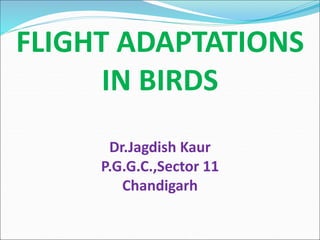
Flight-Adaptation-in-Birds.ppt
- 1. FLIGHT ADAPTATIONS IN BIRDS Dr.Jagdish Kaur P.G.G.C.,Sector 11 Chandigarh
- 2. FLIGHT ADAPTATION IN BIRDS only vertebrates specialized to aerial mode of life. The super order ratitae or palaeognatheae includes the flightless terrestrial birds e.g. Ostrich, Kiwi etc. Super order impennae or spenisciformes includes marine and flightless birds and occur in antarctic region e.g. Penguin. The super order neognatheae includes the flying or modern birds. Flying birds are heavier than air machines and show a number of morphological, anatomical & physiological modifications to suit their aerial mode of life. These are called volant adaptation.
- 4. MORPHOLOGICAL ADAPTATIONS 1. Body Shape Generally spindle shaped or streamlined Lack the extra lateral projection to minimize the resistance in air during flight. 2. Feathery Exoskeleton Feathers are special integumentary derivatives and are one of the diagnostic features of birds, and perform following functions: Contour feathers make the body streamlined. Form an insulating coat to prevent the loss of body heat. Wing quill feather, called remiges provide a large and broad surface area for the air movement.
- 6. 3. Flight Organs The fore limbs are modified into powerful flight organs, called wings. 4. MOBILE NECK & BEAK Transformation of forelimbs into wings is dully compensated by the development of extreme mobility of the long and flexible neck for reaching food. •The mouth is bounded by a horny beak which help in ingestion, nest building etc.
- 8. 5.EQUILIBRIUM • Shifting of light organs towards upper part of body & heavy organ towards lower. • That shifts the centre of gravity to the posterior part of body This low centre of gravity prevent the turning of the body of a bird in the air. 6.STEERING APPARATUS Short tail bearing a tuff of long tail quill feather (retrices), that assist in steering, lifting and counter balancing during flying.
- 9. ANATOMICAL ADAPTATIONS 1. FLIGHT MUSCLES Muscles of back are greatly reduced but the flight muscles are greatly developed and highly vascular. These have long and straited muscle fibses so that they do not undergo fatigue even after prolonged activity. 2. LIGHTNESS AND RIGIDITY OF ENDOSKELETON light and rigid endoskeleton Their endoskeleton is built on hollow girder principle. Rigidity is required to resist the pressure of air current during flight. Lightness achieved through following adaptation: Skull bones are thin and papery. Pneumacity: most of long bones are filled with air spaces to make them light such bones are called Pneumatic bones, which also decreases the specific gravity of the bird.
- 10. In pigeon there are three types of flight muscle. Pectoralis depressor major :- These are largest size flight muscle. Their contraction cause powerful downstroke of wings, arise from the ventral side of sternal keel. Pectoralis elevator muscle :- these arise from anterior part of the sternum . Their contraction cause upstroke of the wings. Accessory muscles :- these supplement the pectoralis muscles to elevate or depress the wings. These are:- 1. coraco – brachialis longus or coraco – brachialis brevis. 2. Biceps and triceps 3. Extensor carpiradialis and extensor carpiulnaris.
- 12. • Presence of Air Sacs • In birds there is tendency towards reduction in the number of bones. • Lightness is also achieved by the loss of certain organs e.g. teeth, gall bladder, urinary bladder and right ovary and oviduct in the female. 3. RIGIDITY IS ACHIEVED THROUGH FOLLOWING ADAPTATIONS: Complete fusion of skull bones so that even the sutures are absent or indistinct between them. Caudal vertebrae are fused to form a small and triangular pygostyle to provide stability in the air.
- 13. PHYSIOLOGICAL ADAPTATION Digestive system: Birds have following adaptation in their digestive system: Beaks are variously modified to intake large amount of food in the mininum period. A masticatory gizzard with a thick cuticular lining is developed to compensate the absence of teeth. Rate of digestion is very high due to immediate utilizations of digestive juices due to presence of two bile ducts and three pencreatic ducts.
- 14. 2. Respiratory system: In birds, the rate of respiration is very high. It is about 25-29 times per minute. To compensate small sized and inelastic lungs, the birds show double respiration in which the lung alveoli receive fresh air during both inspiration and expiration. Air sacs are thin and distensible sacs associated with the lungs.
- 15. CIRCULATORY SYSTEM Avian heart is larger in size, more powerful and more efficient. Their heart is four chambered with double circulation. Rate of heart beat is faster in birds which increase cardiac output and blood supply to various organs of body. RBCS of birds have large amount of haemoglobin. Homeothermy: birds are warm blooded or homeothermal vertebrates.
- 16. 5. EXCRETORY SYSTEM: Loop of henle is long sized. Urinary bladder is absent so that nitrogenous wastes are immediately expelled out of the body. Brain and sense organs: Birds have to depend more on the sense of sight to locate their food so that optic lobe of midbrain and eyes are well developed. Brain is large sized and well developed to co- ordinate the complex movements of wings and the feathers during flight.
- 17. These adaptation reveals that flight in birds is a technical wonder which enables them to explore new habitats for food and shelter and to escape from the unfavourable climatic condition and enemies.